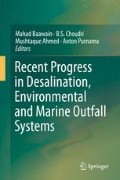Abstract
Desalination is the method of removing salts from brackish or sea water in order to produce fresh water. Desalting is a natural and continual process which is an essential part of the water cycle. After rainfall, rain water carries dissolved minerals and other materials along the way to the sea, which makes the water increasingly salty. Through the sun’s energy, the evaporation of water leaves the salts behind and the resulting water vapor forms clouds that produce rain thus continuing the water cycle.
Access this chapter
Tax calculation will be finalised at checkout
Purchases are for personal use only
References
Ahmed M, Shayya W, Hoey D, Al-Handhaly J (2001) Brine disposal from RO plants in Oman and the United Arab Emirates. Desalination 133:135–147
Ahmed M, Shayya WH, Hoey D, Al-Handaly J (2002) Brine disposal from inland desalination plants: research needs assessment. Water Int 27(2):194–201
Ahmed M, Hoey D, Shayya W, Goosen MFA (2004) Brine disposal from inland desalination plants: current status, problems, and opportunities. Published in Volume II of Environmental Sciences and Environmental Computing (Electronic Book Series). EnviroComp Consulting, Inc., Fremont, California, USA
American Water Works Association (AWWA) (1999) Manual of water supply practices: reverse Osmosis and nanofiltration. M46, AWWA, Denver
Birkett JD (1984) A brief illustrated history of desalination: from the Bible to 1940. Desalination 50:17–52
Brandt DC (1985) Seawater reverse osmosis: an economic alternative to distillation. Desalination 52:177–186
Burke PA (2013) Understanding desalination: the well that won’t run dry. Water Technology Magazine 36 (Edition 4), 01 April 2013
Dawoud MA, Al Mulla MM (2012) Environmental impacts of seawater desalination: Arabian Gulf case study. Int J Environ Sustain 1(3):22–37
Desalination Yearbook (2011–2012) Water desalination report. International Desalination Association (IDA). Desalination Year Book, IDA, Australia
El-Dessouky HT, Ettouney HM (2002) Fundamentals of salt water desalination. Elsevier, Amsterdam
Global Water Intelligence (2012) Industrial desalination and water reuse report. Global Water Intelligence Office, Waterhub, Singapore
Henthorne L (2009) Desalination: a critical element of water solutions for the 21st century. In: Forare J (ed) Drinking water – sources, sanitation and safeguarding. The Swedish Research Council Formas, Sweden
International Desalination Associates (IDA) (1987) IDA worldwide desalting plants inventory. Wangnick Consulting Engineers, Gnarrenburg
International Desalination Associates (IDA) (2011) Desalination and the Gulf: the relationship between the environment and meeting the region’s water needs. Environmental symposium on Desalination and the Gulf, Manama, 6–7 December 2010
Lattemann S, Hopner T (2003) Seawater desalination impacts of brine and chemical discharges on the marine environment. Desalination Publications, L’Aquila
Lattemann S, Hopner T (2008) Environmental impact and impact assessment of seawater desalination. Desalination 220(1–3):1–15
Maalouf S (2014) Planning and design of desalination plants effluent systems. PhD thesis, UCLA Electronic Theses and Disserations, University of California, USA
Sanz MA (2012) A look to desalination world. A presentation at the 3rd International Seminar on Desalination, Hotel Enjoy, Antofagasta, 1–October 2012, International Desalination Association, Australia
Sood A, Smakhtin V (2014) Can desalination and clean energy combined help to alleviate global water scarcity? J Am Water Resour Assoc 50(5):1111–1123
UNEP/MAP/MEDPOL (2003) Sea water desalination in the Mediterranean: assessment and guidelines, MAP technical reports series no. 139, United Nations Environment Programme (UNEP), Mediterranean Action Plan (MAP), Programme for the Assessment and Control of Pollution in the Mediterranean region (MEDPOL), Athens
Van der Bruggen B, Vandecasteele C (2002) Distillation vs. membrane filtration: overview of process evolutions in seawater desalination. Desalination 143(3):207–218
Younos T, Tulou KE (2005) Overview of desalination techniques. J Contemp Water Res Educ 132(1):3–10
Author information
Authors and Affiliations
Corresponding author
Editor information
Editors and Affiliations
Rights and permissions
Copyright information
© 2015 Springer International Publishing Switzerland
About this chapter
Cite this chapter
Baawain, M., Choudri, B.S., Ahmed, M., Purnama, A. (2015). An Overview: Desalination, Environmental and Marine Outfall Systems. In: Baawain, M., Choudri, B., Ahmed, M., Purnama, A. (eds) Recent Progress in Desalination, Environmental and Marine Outfall Systems. Springer, Cham. https://doi.org/10.1007/978-3-319-19123-2_1
Download citation
DOI: https://doi.org/10.1007/978-3-319-19123-2_1
Publisher Name: Springer, Cham
Print ISBN: 978-3-319-19122-5
Online ISBN: 978-3-319-19123-2
eBook Packages: Earth and Environmental ScienceEarth and Environmental Science (R0)

